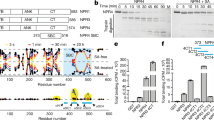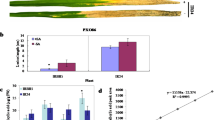Abstract
Salicylic acid (SA) is a plant immune signal produced after pathogen challenge to induce systemic acquired resistance. It is the only major plant hormone for which the receptor has not been firmly identified. Systemic acquired resistance in Arabidopsis requires the transcription cofactor nonexpresser of PR genes 1 (NPR1), the degradation of which acts as a molecular switch. Here we show that the NPR1 paralogues NPR3 and NPR4 are SA receptors that bind SA with different affinities. NPR3 and NPR4 function as adaptors of the Cullin 3 ubiquitin E3 ligase to mediate NPR1 degradation in an SA-regulated manner. Accordingly, the Arabidopsis npr3 npr4 double mutant accumulates higher levels of NPR1, and is insensitive to induction of systemic acquired resistance. Moreover, this mutant is defective in pathogen effector-triggered programmed cell death and immunity. Our study reveals the mechanism of SA perception in determining cell death and survival in response to pathogen challenge.
This is a preview of subscription content, access via your institution
Access options
Subscribe to this journal
Receive 51 print issues and online access
$199.00 per year
only $3.90 per issue
Buy this article
- Purchase on Springer Link
- Instant access to full article PDF
Prices may be subject to local taxes which are calculated during checkout




Similar content being viewed by others
References
Jones, J. D. & Dangl, J. L. The plant immune system. Nature 444, 323–329 (2006)
Lorrain, S., Vailleau, F., Balague, C. & Roby, D. Lesion mimic mutants: keys for deciphering cell death and defense pathways in plants? Trends Plant Sci. 8, 263–271 (2003)
Durrant, W. E. & Dong, X. Systemic acquired resistance. Annu. Rev. Phytopathol. 42, 185–209 (2004)
Chen, Z., Silva, H. & Klessig, D. Involvement of reactive oxygen species in the induction of sytemic acquired resistance by salicylic acid in plants. Science 262, 1883–1886 (1993)
Park, S. W., Kaimoyo, E., Kumar, D., Mosher, S. & Klessig, D. F. Methyl salicylate is a critical mobile signal for plant systemic acquired resistance. Science 318, 113–116 (2007)
Slaymaker, D. H. et al. The tobacco salicylic acid-binding protein 3 (SABP3) is the chloroplast carbonic anhydrase, which exhibits antioxidant activity and plays a role in the hypersensitive defense response. Proc. Natl Acad. Sci. USA 99, 11640–11645 (2002)
Cao, H., Glazebrook, J., Clark, J. D., Volko, S. & Dong, X. The Arabidopsis NPR1 gene that controls systemic acquired resistance encodes a novel protein containing ankyrin repeats. Cell 88, 57–63 (1997)
Spoel, S. H. & Dong, X. How do plants achieve immunity? Defence without specialized immune cells. Nature Rev. Immunol. 12, 89–100 (2012)
Pintard, L., Willems, A. & Peter, M. Cullin-based ubiquitin ligases: Cul3-BTB complexes join the family. EMBO J. 23, 1681–1687 (2004)
Spoel, S. H. et al. Proteasome-mediated turnover of the transcription coactivator NPR1 plays dual roles in regulating plant immunity. Cell 137, 860–872 (2009)
Zhang, Y. et al. Negative regulation of defense responses in Arabidopsis by two NPR1 paralogs. Plant J. 48, 647–656 (2006)
Santner, A. & Estelle, M. Recent advances and emerging trends in plant hormone signalling. Nature 459, 1071–1078 (2009)
Tan, X. et al. Mechanism of auxin perception by the TIR1 ubiquitin ligase. Nature 446, 640–645 (2007)
Sheard, L. B. et al. Jasmonate perception by inositol-phosphate-potentiated COI1-JAZ co-receptor. Nature 468, 400–405 (2010)
Métraux, J.-P. et al. in Advances in Molecular Genetics of Plant-Microbe Interactions Vol. 1 (eds Hennecke, H. & Verma, D. P. S. ) 432–439 (Kluwer Academic Publishers, 1991)
Mou, Z., Fan, W. & Dong, X. Inducers of plant systemic acquired resistance regulate NPR1 function through redox changes. Cell 113, 935–944 (2003)
Nawrath, C., Heck, S., Parinthawong, N. & Métraux, J.-P. EDS5, an essential component of salicylic acid-dependent signaling for disease resistance in Arabidopsis, is a member of the MATE transporter family. Plant Cell 14, 275–286 (2002)
Wildermuth, M. C., Dewdney, J., Wu, G. & Ausubel, F. M. Isochorismate synthase is required to synthesize salicylic acid for plant defence. Nature 414, 562–565 (2001)
Gaffney, T. et al. Requirement of salicylic acid for the induction of systemic acquired resistance. Science 261, 754–756 (1993)
Malamy, J., Carr, J. P., Klessig, D. F. & Raskin, I. Salicylic acid: a likely endogenous signal in the resistance response of tobacco to viral infection. Science 250, 1002–1004 (1990)
Enyedi, A. J., Yalpani, N., Silverman, P. & Raskin, I. Localization, conjugation, and function of salicylic acid in tobacco during the hypersensitive reaction to tobacco mosaic virus. Proc. Natl Acad. Sci. USA 89, 2480–2484 (1992)
Dorey, S. et al. Spatial and temporal induction of cell death, defense genes, and accumulation of salicylic acid in tobacco leaves reacting hypersensitively to a fungal glycoprotein. Mol. Plant Microbe Interact. 10, 646–655 (1997)
Torres, M. A., Jones, J. D. G. & Dangl, J. L. Pathogen-induced, NADPH oxidase-derived reactive oxygen intermediates suppress spread of cell death in Arabidopsis thaliana. Nature Genet. 37, 1130–1134 (2005)
Lu, H. et al. Genetic analysis of acd6-1 reveals complex defense networks and leads to identification of novel defense genes in Arabidopsis. Plant J. 58, 401–412 (2009)
Rate, D. N. & Greenberg, J. T. The Arabidopsis aberrant growth and death2 mutant shows resistance to Pseudomonas syringae and reveals a role for NPR1 in suppressing hypersensitive cell death. Plant J. 27, 203–211 (2001)
Dieterle, M. et al. Molecular and functional characterization of Arabidopsis Cullin 3A. Plant J. 41, 386–399 (2005)
Mackey, D., Holt, B. F., Wiig, A. & Dangl, J. L. RIN4 interacts with Pseudomonas syringae type III effector molecules and is required for RPM1-mediated resistance in Arabidopsis. Cell 108, 743–754 (2002)
Rossignol, P., Collier, S., Bush, M., Shaw, P. & Doonan, J. H. Arabidopsis POT1A interacts with TERT-V(I8), an N-terminal splicing variant of telomerase. J. Cell Sci. 120, 3678–3687 (2007)
Nallamsetty, S., Austin, B. P., Penrose, K. J. & Waugh, D. S. Gateway vectors for the production of combinatorially-tagged His6-MBP fusion proteins in the cytoplasm and periplasm of Escherichia coli. Protein Sci. 14, 2964–2971 (2005)
Fan, W. & Dong, X. In vivo interaction between NPR1 and transcription factor TGA2 leads to salicylic acid-mediated gene activation in Arabidopsis. Plant Cell 14, 1377–1389 (2002)
Acknowledgements
We thank Y. Zhang for sharing the npr3, npr4, npr3 npr4 and npr1 npr3 npr4 mutants; J. Song for providing the NPR3 and NPR4 Y2H constructs; Z. Mou for providing the data on the NPR1–GFP protein levels in the nahG transgenic plants, P. Zhou for discussion of the work and for critiquing the manuscript. This work was supported by the Hargitt Fellowship (to Z.Q.F.), grants GM069594-05 (to X.D.), CA107134 (to N.Z.), T32GM008268-23 (to J.R.), Grants-in-Aid for Scientific Research (no. 23120520) from the Ministry of Education, Culture, Sports, Science and Technology of Japan (to Y.T). and the Royal Society Uf090321 (to S.H.S.). N.Z. is a Howard Hughes Medical Institute investigator and X.D. is a Howard Hughes Medical Institute-Gordon and Betty Moore Foundation investigator.
Author information
Authors and Affiliations
Contributions
Z.Q.F., S.Y., A.S., R.M. and S.H.S. conceived and discovered that NPR3 and NPR4 mediate NPR1 degradation. Z.Q.F., A.S. and S.Y. found that SA regulates the interactions between the NPR proteins. S.Y., W.W. and A.S. found that NPR3 and NPR4 can bind SA with different affinities. J.R. and N.Z. showed that purified NPR4 recombinant protein exists as a tetramer, which is competent in SA binding. Z.Q.F., W.W. and R.M. demonstrated that the npr3 and npr4 single and double mutants are impaired in ETI and SAR. N.O. and Y.T. observed in situ accumulation of NPR1(C82A)–GFP in response to Psm ES4326/avrRpt2. S.H.S. provided data on the detection of NPR1–GFP protein in eds5 and ics1 plants. X.D. designed the research and, together with Z.F., S.Y., W.W., S.H.S., A.S. and R.M., wrote the manuscript.
Corresponding author
Ethics declarations
Competing interests
The authors declare no competing financial interests.
Supplementary information
Supplementary Information
This file contains Supplementary Figures 1-9 and Supplementary Table 1. (PDF 753 kb)
Rights and permissions
About this article
Cite this article
Fu, Z., Yan, S., Saleh, A. et al. NPR3 and NPR4 are receptors for the immune signal salicylic acid in plants. Nature 486, 228–232 (2012). https://doi.org/10.1038/nature11162
Received:
Accepted:
Published:
Issue Date:
DOI: https://doi.org/10.1038/nature11162
This article is cited by
-
A plant cell death-inducing protein from litchi interacts with Peronophythora litchii pectate lyase and enhances plant resistance
Nature Communications (2024)
-
DkWRKY transcription factors enhance persimmon resistance to Colletotrichum horii by promoting lignin accumulation through DkCAD1 promotor interaction
Stress Biology (2024)
-
The expression of the NPR1-dependent defense response pathway genes in Persea americana (Mill.) following infection with Phytophthora cinnamomi
BMC Plant Biology (2023)
-
Cotton microbiome profiling and Cotton Leaf Curl Disease (CLCuD) suppression through microbial consortia associated with Gossypium arboreum
npj Biofilms and Microbiomes (2023)
-
Different viral effectors suppress hormone-mediated antiviral immunity of rice coordinated by OsNPR1
Nature Communications (2023)
Comments
By submitting a comment you agree to abide by our Terms and Community Guidelines. If you find something abusive or that does not comply with our terms or guidelines please flag it as inappropriate.



